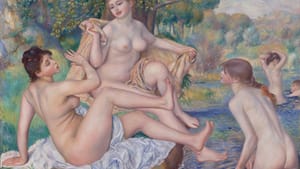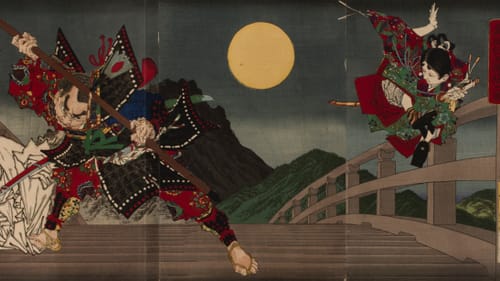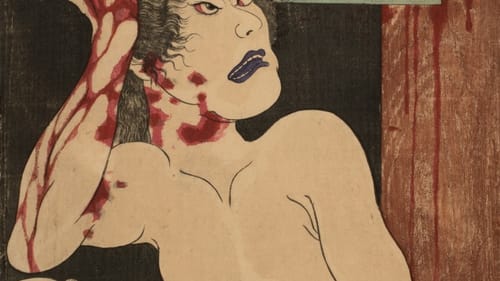Stay in the Loop
BSR publishes on a weekly schedule, with an email newsletter every Wednesday and Thursday morning. There’s no paywall, and subscribing is always free.
A fresh look at the Impressionists
The Philadelphia Museum of Art presents Yoshitoshi and Impressionism

Interpreting the world is what artists do, and the late 19th century made for a challenging canvas. Trade penetrated insular cultures, novel methods of communication connected vastly different peoples, and new attitudes permeated tradition-bound societies. Artists’ responses to these forces are the subject of Yoshitoshi: Spirit and Spectacle and The Impressionist’s Eye at Philadelphia Museum of Art (PMA).
Multimedia expansions
These companion exhibits draw on PMA’s rich collection to examine Eastern and Western perspectives. The Impressionist’s Eye provides new views of Impressionism and Post-Impressionism through works in various media, highlighted by Renoir’s The Great Bathers (1884-1887), newly conserved and glowing.
Curated by Jennifer Thompson, the exhibit is organized along themes such as nature, everyday objects, and people, facilitating comparisons among artists and shedding light on the cropping, perspective, color, and brushwork that made Impressionism such a departure. The exhibit offers fresh insight into a well-known, much-loved movement.
Meanwhile, in Japan
Though less renowned than Cézanne and company, Tsukioka Yoshitoshi (1839-1892), who worked slightly earlier than the Impressionists, also forced his compatriots to see in new ways.
Considered the last master of Japanese woodblock printing, Yoshitoshi’s career bridged the transition of Japan from feudal society to modern nation. Woodblock printing, or ukiyo-e, was dying when he began rendering Japan’s classic battles, legends, and nature in richly colored, lively depictions that resurrected the genre. Yoshitoshi’s prints, vivid and vibrating with action, began a bright line that led to today’s popular anime and manga styles. His works comprise about a fifth of PMA’s Japanese print collection.
As he celebrated traditional topics and characters, Yoshitoshi included contemporary allusions with enough subtlety to evade Japan’s then-strict censorship. (Drawings had to be approved by authorities before being reproduced by carvers in blocks of cherry wood.)

Battles and blood
In General Masakiyo at Shinshū Castle during the Invasion of Korea in 1590 (1863), Yoshitoshi commented on a 19th-century conflict with Britain through a historic battle—the giveaway is St. Paul’s Cathedral in the background, veiled in smoke but easily visible.
Yoshitoshi’s art looks quite different from the misty, quiet images emblematic of Japanese prints. His scenes crackle with life: people grimace, purse their lips in amusement, and wave their arms. Shoguns slash swords, serpents coil threateningly, and ninjas hurl themselves into the fray. Colors are bold, especially when blood has been spilled—and in prints from the 1860s, Yoshitoshi spilled a lot of it.
According to Shelley Langdale, the PMA's associate curator of prints and drawings and the organizer of Spirit and Spectacle, Yoshitoshi’s palette benefitted from the opening of trade, which gave him new dyes to lavish on prints. While the pinks, purples, and greens still appear intense, Yoshitoshi’s red makes you want to grab a tourniquet. It’s a viscous crimson that floods the field, especially in Reisei Hangan Takatoyo Dying of Disembowelment (1868), in which it drips down the subject’s fingers and spurts across his midsection. Thankfully, the gore represents only a portion of the artist’s oeuvre.
Traditional women, modern inclinations
Yoshitoshi also shifted views of women, drawing not only ladies-in-waiting, concubines, and women bathing but a woman dressed in Western fashion who might have been strolling in Tokyo or New York. Then there is Matsumoto Ai, a Female Bonesetter in Ōsaka, Using Judo to Drive Away Four Ruffians Who Tried to Rape Her (1875-1876), a heroine who tosses assailants over an embankment. And there's I Want to Cancel My Subscription (Woman Reading Newspaper) (1878), in which a traditionally dressed woman curls up on the floor, the news of the day spread before her.

See all about it
The growth of Japan’s newspaper industry created a steady demand that reinvigorated Yoshitoshi’s career. He was commissioned in 1875 by the Postal Newspaper to illustrate current events for readers who now expected visuals with text, thanks to the popularization of photography. Yoshitoshi’s enthusiastic style was perfectly suited to the task.
Among the Postal Newspaper prints on view are The Black Monster Attacking the Wife of a Carpenter in Junda (1875), in which a lizard-like ghost hovers face-to-face over a prone woman while her husband recoils in fright—she’s unconscious, he’s hysterical. In Crowds Thronging to See the Whale Exhibited at Fukagawa (c 1875-76), masses of looky-loos have come to see a whale well past its expiration date. Yoshitoshi’s observers curl arms over their heads, hold noses, and tie bandannas across their faces to fend off the odor.
Though he incorporated modern attitudes and current events, Yoshitoshi embraced the past, pursuing the medium of woodblock print and celebrating traditional subjects. Late in his career, he executed his best-known series, One Hundred Aspects of the Moon (1885-1892), in which the moon is a backdrop for iconic characters engaged in an array of endeavors: a courtesan weeps, one actor composes a poem, another portrays a ghost, a fireman contemplates the celestial orb through smoke, and a warlord sounds a call on a conch shell. The entire series is in the PMA collection, and a quarter of it is here.
Like the Impressionists, Yoshitoshi expanded visual and psychological horizons, welcoming the new without abandoning cultural heritage.
What, When, Where
Yoshitoshi: Spirit and Spectacle and The Impressionist’s Eye. Through August 18, 2019, at the Philadelphia Museum of Art, 2600 Benjamin Franklin Parkway, Philadelphia. 215-763-8100 or philamuseum.org.
PMA welcomes visitors with disabilities. Accessible parking is available in the museum garage, and the west entrance is barrier-free. ADA-accessible restrooms are available on each floor of the museum, and wheelchairs are available to borrow on a first-come, first-served basis. Resources and materials for deaf and hard-of-hearing visitors and blind or low-vision visitors are available. For more information, contact PMA’s Office of Accessible Programs at [email protected].
Sign up for our newsletter
All of the week's new articles, all in one place. Sign up for the free weekly BSR newsletters, and don't miss a conversation.
